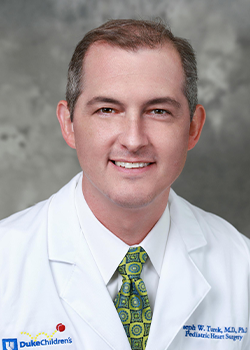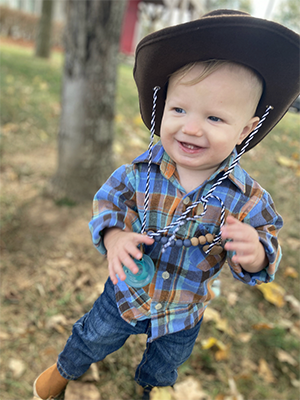
Saving More Babies Through Innovation in Pediatric Heart Surgery
Pediatric heart surgeon Joseph Turek, MD, PhD, MBA, who saves lives on a daily basis, believes he has the most rewarding profession there is. “I’m able to help children and their families every day with what I do in the operating room,” Turek said. He is chief of Pediatric Cardiac Surgery at Duke Health.
Turek loves the technical challenges of operating on hearts the size of strawberries. The stakes are high, and Turek relishes that. “I love having the responsibility of taking care of children and giving a good result,” he said.

But as a surgeon-scientist, Turek wants to have an impact beyond the individual babies and families he helps at Duke. He wants to change the field of pediatric cardiac surgery.
Since he joined the faculty at Duke University School of Medicine in 2017, Turek has already developed several new surgical techniques and strategies that promise to save more babies and improve surgical outcomes.
“He has truly transformed the program here,” said Department of Surgery Chair Allan Kirk, MD, PhD. “The care that is given to children with heart disease is now among the best in the world and arguably the best in the country. That sort of movement from a small insignificant program to being one of national import in six years is unimaginable. Beyond that, he is truly creating new procedures and therapies that weren’t even imagined before he got here.”
Two of Turek’s most significant innovations are the partial heart transplant and the heart-thymus co-transplant.
Partial Heart Transplant
In the spring of 2022, Turek performed the world’s first partial heart transplant on a 17-day-old baby named Owen, integrating two arteries and valves from a donor infant into Owen’s heart.
Almost two years later, Owen is thriving. Turek expects the valves to last a lifetime, unlike a full infant heart transplant, which typically lasts 21 years. Owen also gets by on fewer anti-rejection medicines than he would have with a full heart transplant.
Owen was born with two of his major heart arteries fused into a single vessel that had a very leaky valve. He was put on the list for a heart transplant but wasn’t expected to survive the months-long wait for one. Turek knew Owen didn’t really need a whole new heart; he just needed new arteries and valves. Transplanting only the arteries and valves hadn’t been done before, but Turek was ready and willing.
He had already come up with the concept of a partial heart transplant and made it a focus of his research. One of the motivations behind the procedure is that many hearts available for donation aren’t strong enough to be used but have perfectly good valves. Another benefit is that valves from a donor heart would grow along with a child, eliminating the current need for children with faulty valves to have repeated surgical implantation of cadaver valves, which don’t grow.
Still, even with research and preparation, the first case is a leap of faith. “You have to find a situation where that leap of faith is justified,” Turek said.
Owen’s outlook for survival was so dire that his family decided to go ahead with the new operation. “It was the right time, the right patient, and the right family that put their faith in us to do this,” Turek said. “All the stars aligned.”

The partial heart transplant not only saved Owen’s life, it also made history by using functional parts of a heart that would have otherwise been discarded.
Making better use of an available heart is something that helps two families. “You’ve got a grieving family, like Owen’s donor’s family,” Turek said. “Often they want to save a life in the midst of their tragedy and a lot of times, they can’t donate the heart because it’s not [strong enough].”
Partial heart transplants open new opportunities in several other ways. One is the ability to perform “domino” transplants, in which a child who receives a new heart donates their own valves to a second baby.
In another scenario, called “split root,” two valves from one donor heart can go to two different children who need only one.
It all adds up to more lives saved with the same number of donor hearts. In fact, Turek said, partial heart transplant could double the number of children saved.
“The idea is that we are being good stewards of these gifts of life,” Turek said, “and helping out more and more kids that we wouldn’t have been able to help in the past.”
Already, 13 children have received partial heart transplants, including dominos and split roots. Nine of these have happened at Duke, and four at other medical centers with guidance from Turek.
So far, all have involved valves, but Turek expects the concept of partial heart transplant to expand. “In doing this first partial heart transplant, we really created an entire new field within cardiac surgery,” he said. “Ultimately, this is going to encompass many parts of the heart.”
Heart-Thymus Co-Transplant
In another pediatric heart surgery first, Turek led the co-transplantation of a heart and a thymus, which is a gland that builds the immune system during childhood.
Turek teamed up with Louise Markert, MD, PhD, professor of pediatrics (now emeritus), who has decades of experience with thymus implantation. “Duke is the only place in the western hemisphere that does cultured thymus implants,” Turek said. “It’s a Duke thing.”
Markert used cultured thymus implants to treat babies born without a thymus. These babies, with no immune system to protect them from even minor infections, would usually die before their third birthday.
In the technique developed by Markert, thymus tissue is cultured in the lab, using tissue trimmed away during certain surgical procedures. When the tissue is ready, it is implanted in babies. There, it begins its work as a “schoolhouse” for white blood cells, directing the development of T-cells that recognize and attack infectious invaders.
WATCH: Celebrating the First Heart-Thymus Transplant
Turek and Markert thought that transplanting a heart and thymus from the same donor would prevent the immune system from attacking the heart, because the thymus would recognize it as “self.” That could mean fewer toxic anti-rejection drugs and longer lives for implanted hearts.
In 2021, one of Turek’s patients, a baby named Easton, was on the list for a heart transplant when it was discovered he did not have a functioning immune system. Turek recognized a golden opportunity.
Easton’s family was willing to try the new procedure, so Easton received a new heart and, two weeks later, thymus tissue from the same donor. Today he is happy and healthy and requires only small doses of anti-rejection medicine, which he may be able to stop one day.
Recently, Easton’s story was featured during Duke’s Centennial Kickoff Event.
In the future, implanting cultured thymus tissue during transplantation of any organ, even in adults, could improve outcomes and lengthen the lives of the transplanted organs.
“It has enormous potential to change the field of transplant,” Turek said.
From Innovation to Standard of Care
While partial heart transplant and heart-thymus co-transplant are two of Turek’s biggest contributions to the field, they are certainly not the only ones. He has been working with other Duke pediatric heart surgeons to transplant pediatric hearts donated after circulatory death (DCD) -- hearts that were previously unusable for transplant.
And the ideas keep coming. They bubble up at any time, whether at work or at home, where he stays active with his wife and three children, running, biking, and coaching basketball.
“He calls me at all hours of the day,” said Douglas Overbey, MD, MPH, assistant professor of surgery and the first to complete the Department of Surgery’s Congenital Cardiac Surgery Fellowship, established by Turek. “He’ll just spring these ideas that come to him at 8 p.m. and we’re talking about what the next frontier will look like and how we can push it forward.”
Turek refines his ideas and practices new techniques in his lab, so he’s prepared to pilot them when the right patient comes along. “Some of these procedures that he’s done were very in the moment,” Kirk said. “He saw it and thought, ‘We can do this.” That’s quite rare. He has an inner confidence that is matched by his true competence.”
When Turek performs a surgery that’s never been done before, he’s doing it to save the life of a particular child. But he’s also leading the way, very intentionally, to a better future for all children with congenital heart disease.
“My hope for all of these innovations is that they are able to scale over the next decade to become something not just offered at a few select centers,” Turek said. “Can you imagine how many children you can help if these innovations are standard of care and everyone’s doing them?”
You get the feeling that Turek can already see it.
Mary-Russell Roberson is a freelance writer in Durham.
Main Photo: Joseph Turek, MD, PhD, a pediatric heart surgeon, holds baby Owen Monroe during a follow-up appointment in 2022 at Duke University Hospital after a partial heart transplant.
